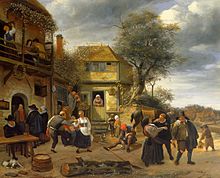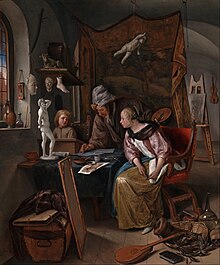Jan Steen
[1] Steen was born in Leiden, a town in Southern Holland, where his well-to-do, Catholic family were brewers[2] who ran the tavern The Red Halbert for two generations.
Like his even more famous contemporary Rembrandt van Rijn, Jan Steen attended the Latin school and became a student in Leiden.
Though no official records of Steen's artistic training are preserved, contemporary sources tell us he received his painterly education from three men, Nicolaes Knupfer (1603–1660), a German painter of historical and figurative scenes in Utrecht, Adriaen van Ostade, and Jan van Goyen, who would later become his father-in-law.
Soon after he became an assistant to the renowned landscape painter Jan van Goyen (1596–1656), and moved into his house on the Bierkade in The Hague.
Steen worked with his father-in-law until 1654, when he moved to Delft, where he ran the brewery De Slang ("The Snake") for three years without much success.
[6] In 1945, Sturla Gudlaugsson, a specialist in Dutch seventeenth-century painting and iconography and Director of the Netherlands Institute for Art History and the Mauritshuis in The Hague, wrote The Comedians in the work of Jan Steen and his Contemporaries, which revealed that a major influence on Jan Steen's work was the guild of the Rhetoricians or Rederijkers and their theatrical endeavors.
The humanity, humour and optimism of the figures suggest that Jan Steen knew these men well, and wanted to portray them positively.
Steen's numerous paintings of a theme most commonly entitled The Doctor's Visit, such as the composition of 1665–1670 in the Rijksmuseum, illustrate his theatrical approach.
In contrast, the girl wears what would be the height of fashion at the time of the painting, a Japanese-styled loose kimono robe.
Jan Steen’s works followed the theme "every painter paints himself", depicting lively scenes reminiscent of his own home.
In the two paintings, The way you hear it and As old men sing, so children squeal, six of the people are identical in person and pose, and their spatial relationship is similar.





